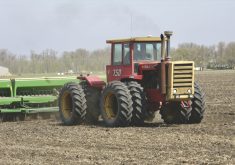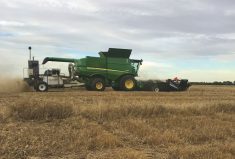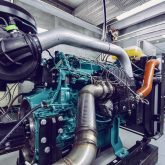Like so much of China, the country’s agriculture is in a state of transition. While some sectors of the industry are barreling full speed into mechanization, with impressive rates of technology adoption to match the latest in global production standards, the road to modernizing agricultural production isn’t always a smooth one.
China is the world’s second-largest economy and with 1.4 billion inhabitants, it is home to one-fifth of the global population — but the country has only nine per cent of the world’s arable land, and seven per cent of its fresh water.
Read Also

Riding the tariff rollercoaster
Farmers are accustomed to roller-coaster years. But the current geopolitical windstorm is something else entirely. On his cattle operation near…
Since the 1980s, the country has been urbanizing with astonishing speed — building up its cities at a rate unrivalled in world history — with 60 per cent of the population expected to live in urban areas by 2020.
By comparison, 60 per cent of the country’s population was considered rural only two decades ago.
Canadian farmers have some experience in this too, and they know that one of the impacts of urbanization is to make it much harder to find farm employees.
It’s the same in China, where urbanization has led to a mass exodus of workers from the countryside. According to Statista.com, 44.8 per cent of China’s population worked in agriculture in 2005. But that dropped to 28.3 per cent by 2015.
Suddenly, agriculture had an amazing opportunity to meet the food demands of a booming middle class, but also the challenge of how to produce that food with a shrinking labour force.
For the Chinese government, the answer to both lies with mechanization and land consolidation. In pursuit of its long-standing target of achieving 95 per cent self-sufficiency in food grains by 2020, this has resulted in the creation of large co-operative-style farms that work their own land allocations, as well as those of their members and of other farmers.
Unlike many Western countries where land ownership lies at the citizen level, it’s the state that owns the land in China. Farmers can retain control of their land allocations themselves or they can transfer those rights to a co-operative and become employees of the co-op.

The Beijing Xingnongtianli Agricultural Machinery Co-operative near Beijing, for example, works approximately 2,000 hectares and provides agronomy, equipment repair and cropping services for over 2,000 farms. Farmers who join the co-op receive 1,200 Yuan Renminbi/MU per year (roughly $1,500 per acre). They also earn wages of 3,000 RMB/month ($585), and enjoy social insurance and paid leave.
More than 40,000 such co-operatives have formed in China since 2006, doing everything from producing crops and livestock to performing contract field work and providing agronomic training.
The Agricultural Industry Mechanization Association, in turn, works to boost mechanization in the countryside by educating both co-ops and individual farmers in how agronomy and equipment can help increase yields and productivity.
The sheer size and geographic diversity of China makes that a challenging undertaking, though. In northern China, where farm sizes are larger, high-horsepower tractors and combines are widely used, but they’re not appropriate in the southern regions of the country where farms and field sizes are much smaller.
It’s important to keep in mind, too, that the average size of China’s estimated 220 million farms remains at about one-sixth of an acre. Small farmers cling to old ways, so basic things can be hard to change, like corn cobs that are mechanically harvested but are still manually laid out to dry in the open air.
“Many farmers are not well educated, they are 50 to 60 years old, and are slow to adopt new techniques so it takes time,” says Yang Lin, vice-president of the Agricultural Industry Mechanization Association.
This has slowed the pace of land reform, but there’s no doubt mechanization is setting the course for agriculture’s future in China.
Not only can bigger tracts of land be more easily worked with larger farm machinery, increasing yield and productivity, they also address the cost and availability of labour. That seems an almost counterintuitive challenge for a country with a labour force the size of China’s, but it’s a common lament in the countryside.
The Jianhu Lantian Agricultural Machinery Co-operative was established in 2007 near the city of Yancheng in Jiangsu Province north of Shanghai.
It includes 30,000 MU (2,000 ha) in its home county of Jianhu and another 18,000 MU (1,200 ha) in nearby Lugoutown County and is considered a technology leader in the region, investing in a fleet of modern machinery that includes 15 harvesters, 28 tractors and a UAV.
“I love the mechanization of agriculture and I love planting,” says general manager Lan Jiasheng. “But lack of labour is a problem. With many adults going to the city, it is people aged 60-plus who are working on the land. Labour is hard to get and expensive.”

The UAV, which is used to spray rice paddies and small strips of land alongside expressways, cost him 53,000 RMB ($10,000) but that’s an investment Lan Jiasheng says can pay for itself in as little as nine days.
With labour at 150 RMB ($30) per person per day, he needs 40 people to spray the amount of land that the UAV can cover in one day — for a total daily cost of 6,000 RMB ($1,200).
GPS technology has also come to Jiangsu Province, population 80 million, and one of China’s leading agricultural areas with approximately one million hectares of planted area. Today, about 200 tractors use GPS on the province’s big farms, according to local farm equipment dealers, with the next step in innovation and labour-saving technology being precision farming.
It’s a similar story at the nearby Liyang Haibin machinery co-operative. They too use UAVs and they’ve made the switch from semi-automated machinery to fully automated “smart” equipment for planting, harvesting and drying. What a decade ago took 20 workers now requires only four to five people.
Although farmers are starting to pay more attention to brands when it comes to making equipment purchases, return on investment figures prominently in the decision-making process. Equipment is expensive so many farmers outsource their cropping work to third-party contractors, who value the performance and profitability of their investment.

According to Chen Tao, vice-chair of the Chinese Agricultural Machinery Distribution Association, farmers who buy equipment from local dealers for their own use face an ROI of about six years. This drops to three years if they also do custom work for neighbouring farmers.
“But more popular are co-ops and professional contractors without land who buy and use equipment. They get their return on investment in only one to two years,” Tao said.
To support the drive for mechanization, the Beijing central government instituted a subsidy program for agricultural machinery purchases in 2004, providing a 30 per cent subsidy overall for each machine purchased. Some local governments contributed additional funds — up to 20 per cent in some areas — making it attractive for co-ops, farmers and contractors to buy farm equipment.

Of China’s three largest crops, wheat production is 90 per cent mechanized, corn harvest mechanization has risen from 40 to 60 per cent in the last three years, and rice paddy planting is approaching a mechanization rate of 40 per cent.
It’s unlikely that China will reach its 95 per cent self-sufficiency in food grains by 2020 goal, says Gary Collar, senior vice-president and general manager for Asia Pacific with farm equipment manufacturer AGCO, as the pace of land reform is moving too slowly. But China has seen miraculous change in the last 10 to 15 years and he believes agriculture will hit its mechanization stride.
“Overall, China is mechanizing at a very fast rate. You see this in its infrastructure, so there is no reason to believe that the agricultural sector won’t develop just as fast,” he says.
Lilian Schaer is a freelance agricultural writer from Canada who recently travelled to China as part of an Exposure for Development tour organized by the International Federation of Agricultural Journalists.















